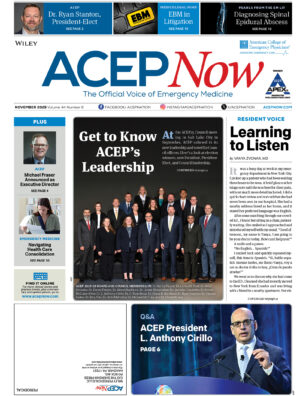
Continual improvement of safe, effective care delivery is a goal of every clinician. Involving our patients in shared decision making and discussing the value of low-yield testing and therapeutics is a fundamental ethical responsibility. The Choosing Wisely campaign, launched by the American Board of Internal Medicine in 2012, aims to publicize and engage clinicians and patients in support of such discussions.1
Explore This Issue
ACEP Now: Vol 33 – No 07 – July 2014Whether this list, or any of the Choosing Wisely recommendations, meets your expectations as representing the “low-hanging fruit” of low-yield care in your clinical setting, these efforts illuminate important cultural changes.
The initiative spans more than 30 specialties, including emergency medicine, and ACEP announced its first five recommendations at ACEP13 in Seattle. These recommendations, covered previously by ACEP Now, address imaging in minor head injury, urinary catheter placement, palliative and hospice care, abscess management, and fluid administration.2 However, many other specialties have produced recommendations for care of patients within their purview that have substantial overlap with the spectrum of care provided in the emergency department. Here are a few of the highlights from across the rest of the medical community:
American Academy of Allergy, Asthma & Immunology
Don’t order sinus computed tomography (CT) or indiscriminately prescribe antibiotics for uncomplicated acute rhinosinusitis.
This very broad recommendation is supported in part by those from the American Academy of Family Physicians, the American Academy of Otolaryngology–Head and Neck Surgery, and the American Academy of Pediatrics. Acute, uncomplicated sinusitis rarely benefits from antibiotic therapy, and the population costs and harms from excessive antibiotic prescribing are undeniable.
American Academy of Family Physicians
Don’t prescribe antibiotics for otitis media in children ages 2–12 years with nonsevere symptoms where the observation option is reasonable.
This is another recommendation, supported by recent American Academy of Pediatrics guidelines, aimed at reducing unnecessary antibiotic overuse.3 Otitis media is nearly universally a self-limited condition, and the observed relative curative benefit of antibiotics is counterbalanced by antibiotic-associated diarrhea and other adverse drug events.4
American Academy of Ophthalmology
Don’t order antibiotics for adenoviral conjunctivitis (pink eye).
Pink eye is contagious, unsightly, and uncomfortable—but typically clinically apparent as a local viral process for which antibiotics are not appropriate or beneficial.
American Academy of Pediatrics
CT scans are not necessary in the immediate evaluation of minor head injuries; clinical observation/Pediatric Emergency Care Applied Research Network (PECARN) criteria should be used to determine whether imaging is indicated.
Neuroimaging (CT, MRI) is not necessary in a child with simple febrile seizure.
CT scans are not necessary in the routine evaluation of abdominal pain.
The use of advanced imaging—particularly ionizing radiation—is of great concern to our pediatrics colleagues. Three of their five recommendations specifically address situations where
excessive low-yield imaging represents costs and harms in excess of the benefits. A shared decision-making conversation given a risk-averse parent represents a challenging patient encounter, but it is our responsibility to protect children from the harms of medical radiation.
American College of Physicians
In the evaluation of simple syncope and a normal neurological examination, don’t obtain brain-imaging studies (CT or MRI).
If dizziness is the emergency physician’s least-favorite complaint, syncope cannot be far behind. Most inpatient syncope evaluations do not identify specific pathology related to syncope, and neuroimaging is of particular low yield. If patients do not have specific high-risk features related to trauma or other neurologic abnormalities, it is preferable to defer such imaging.
American College of Radiology
Don’t do imaging for uncomplicated headache.
This has been the subject of several recent publications as well as a Centers for Medicare & Medicaid Services (CMS) quality measure.5,6 Atraumatic headache absent high-risk features by history of physical should not receive neuroimaging in the emergency department. CT, in particular, is sensitive primarily for hemorrhage but not malignancy, and it may provide false reassurance.
American Society of Anesthesiologists–Pain Medicine
Avoid imaging studies (MRI, CT, or X-rays) for acute low back pain without specific indications.
This recommendation is also supported by the American College of Physicians. Emergency physicians are very familiar with the red flags associated with an increased risk of serious pathology in the setting of acute, atraumatic back pain, and otherwise routine imaging is exceedingly low yield.
American Society of Hematology
Don’t administer plasma or prothrombin complex concentrates for nonemergent reversal of vitamin K antagonists (eg, outside of the setting of major bleeding, intracranial hemorrhage, or anticipated emergent surgery).
Prothrombin complex concentrates, including the recent four-factor product approved in the United States, are efficacious, small-volume means to emergently reverse the coagulopathy associated with warfarin. However, these products are costly and may have increased thrombotic complications compared with fresh frozen plasma. Excepting situations where extremely rapid reversal is necessary, fresh frozen plasma should be utilized for all other conditions necessitating urgent correction.
American Society of Nuclear Cardiology
Don’t perform cardiac imaging for patients who are at low risk.
This broad recommendation has many implications for emergency medicine—and conflicts in some fashion with the current standard of early provocative testing endorsed by the American Heart Association. This medico-legal risk associated with chest pain patients has led to a “zero miss” culture of aggressive, extensive, and low-yield care. It has also further spawned a boom industry in support of CT coronary angiograms in the emergency department. However, all these imaging studies have test characteristics resulting in excessive false positives in a low-risk population, and their suboptimal appropriateness should be part of shared decision making with patients and families.
Society of Hospital Medicine–Pediatric Hospital Medicine
Don’t order chest radiographs in children with uncomplicated asthma or bronchiolitis.
Don’t routinely use bronchodilators in children with bronchiolitis.
Don’t use systemic corticosteroids in children under 2 years of age with an uncomplicated lower respiratory tract infection.
This set of recommendations encompasses a huge subset of pediatric visits to the emergency department, and these tests and interventions may be frequently performed in many settings. Despite the seemingly innocuous nature of these items, they are associated with rare benefits, exceeding the costs and harms.
Likewise, the evolution and additions to these lists are likely to continue in the months and years to come. A study group led by Jeremiah D. Schuur, MD, MHS, FACEP, at Harvard Medical School in Boston used a modified Delphi consensus to create a list of care with “little value” for the institution.8 The process proposed more than 64 items initially, and the team surveyed physicians about 17 of these and ultimately created its own top five:
- Do not order CT of the cervical spine after trauma for patients who do not meet the National Emergency X-ray Utilization Study (NEXUS) low-risk criteria or the Canadian C-Spine Rule.
- Do not order CT to diagnose pulmonary embolism without first risk-stratifying for pulmonary embolism (pretest probability and D-dimer tests if low probability).
- Do not order magnetic resonance imaging of the lumbar spine for patients with lower back pain without high-risk features.
- Do not order CT of the head for patients with mild traumatic head injury who do not meet New Orleans Criteria or Canadian CT Head Rule.
- Do not order coagulation studies for patients without hemorrhage or suspected coagulopathy (eg, with anticoagulation therapy, clinical coagulopathy).
Whether this list, or any of the Choosing Wisely recommendations, meets your expectations as representing the “low-hanging fruit” of low-yield care in your clinical setting, these efforts illuminate important cultural changes. Beyond the specific proposals by each specialty, it is clear physicians are acutely aware of the tests and therapies that are overused despite minimal benefit. These tools provide the first steps toward more robust resource stewardship efforts that will improve the cost-effectiveness of health care delivery.
 Dr. Radecki is assistant professor of emergency medicine at The University of Texas Medical School at Houston. He blogs at Emergency Medicine Literature of Note (emlitofnote.com) and can be found on Twitter @emlitofnote.
Dr. Radecki is assistant professor of emergency medicine at The University of Texas Medical School at Houston. He blogs at Emergency Medicine Literature of Note (emlitofnote.com) and can be found on Twitter @emlitofnote.
References
- ACEP joins Choosing Wisely campaign. ACEP website. Available at: https://www.acepnow.com/article/acep-joins-choosing-wisely-campaign. Accessed June 16, 2014.
- Choosing Wisely website. Available at: http://www.choosingwisely.org. Accessed June 16, 2014.
- Lieberthal AS, Carroll AE, Chonmaitree T, et al. The diagnosis and management of acute otitis media. Pediatr. 2013;131:e964-e999.
- Venekamp RP, Sanders S, Glasziou PP, et al. Antibiotics for acute otitis media in children. Cochrane Database Syst Rev. 2013;1:CD000219.
- Imaging efficiency measures. Quality Net website. Available at: https://qualitynet.org/dcs/ContentServer?c=Page&pagename=QnetPublic%2FPage%2FQnetTier2&cid=1228695266120. Accessed June 16, 2014.
- Schuur JD, Brown MD, Cheung DS, et al. Assessment of Medicare’s imaging efficiency measure for emergency department patients with atraumatic headache. Ann Emerg Med. 2012;60:280-290.
- Napoli AM. The association between pretest probability of coronary artery disease and stress test utilization and outcomes in a chest pain observation unit. Acad Emerg Med. 2014;21:401-407.
- Schuur JD, Carney DP, Lyn ET, et al. A top five list for emergency medicine. JAMA Intern Med. 2014;174:509-515.
Pages: 1 2 3 4 | Multi-Page





No Responses to “Choosing Wisely Recommendations from Medical Specialties Beyond Emergency Medicine”